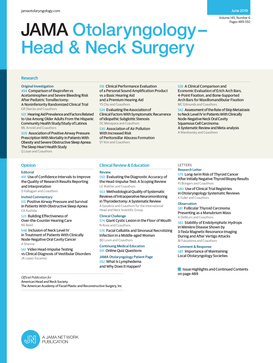Chronic Rhinosinusitis and Mental Health
IF 6
1区 医学
Q1 OTORHINOLARYNGOLOGY
引用次数: 0
Abstract
ImportanceChronic rhinosinusitis (CRS) has been associated with anxiety and depression, but the association of socioeconomic factors and temporality has yet to be fully explored.ObjectiveTo determine the bidirectional risk of anxiety and depression for patients with CRS.Design, Setting, and ParticipantsThis retrospective cohort study of the National Institutes of Health All of Us database from January 1, 2008, to December 31, 2018, included 2 cohorts of adult patients with and without CRS. The data were analyzed from July 1, 2023, through April 1, 2024. Patients were classified as having CRS if they had at least 2 diagnoses during the study period. Those with a diagnosis of CRS before the study period were excluded. Patients were propensity score matched (1:5) with patients without CRS for age, sex, race, and annual household income.Main Outcomes and MeasuresThe primary outcome was the development of anxiety and depression. Patients with CRS were counted as having the primary outcome if it occurred after the criteria for CRS diagnosis were fulfilled. Multivariate logistic regression and survival analysis were performed to determine the odds ratios (ORs) and hazard ratios (HRs) of anxiety and depression. A secondary survival analysis determined the risk of developing CRS between patients with anxiety and depression and controls.ResultsAmong 33 732 patients (23 382 [69.3%] female individuals; 510 [1.5%] Asian, 6002 [17.9%] Black or African American, 576 [1.7%] multiracial, and 26 036 [77.2%] White individuals), there were 28 110 controls and 5622 patients with CRS. Along with higher odds of having anxiety (OR, 4.39; 95% CI, 3.95-4.87) and depression (OR, 2.04; 95% CI, 1.86-2.24), patients with CRS were at an increased risk of developing anxiety (HR, 2.79; 95% CI, 2.47-3.15) and depression (HR, 1.40; 95% CI, 1.27-1.55) compared with controls. Additionally, patients with anxiety (HR, 2.37; 95% CI, 2.18-2.57) and depression (HR, 1.59; 95% CI, 1.46-1.72) were at an increased risk of developing chronic rhinosinusitis compared with controls.Conclusions and RelevanceIn this population-based cohort study of adults with and without CRS, a bidirectional association between common psychiatric disorders and CRS was observed. Physicians and health care clinicians who treat patients with anxiety, depression, and CRS should be vigilant regarding these risks and screen patients appropriately.慢性鼻炎与心理健康
重要性慢性鼻窦炎(CRS)与焦虑和抑郁有关,但社会经济因素和时间性的关联尚未得到充分探讨。目的确定CRS患者焦虑和抑郁的双向风险。设计、设置和参与者这项回顾性队列研究是对美国国立卫生研究院All of Us数据库从2008年1月1日至2018年12月31日的数据进行的研究,包括患有和未患有CRS的两组成年患者。数据分析时间为 2023 年 7 月 1 日至 2024 年 4 月 1 日。如果患者在研究期间至少有两次诊断,则被归类为 CRS 患者。在研究期间之前诊断出 CRS 的患者将被排除在外。患者在年龄、性别、种族和家庭年收入方面与无 CRS 患者进行倾向评分匹配(1:5)。如果CRS患者在符合CRS诊断标准后出现主要结果,则被视为出现主要结果。通过多变量逻辑回归和生存分析,确定焦虑和抑郁的几率比(OR)和危险比(HR)。结果在 33 732 名患者(23 382 名[69.3%]女性;510 名[1.5%]亚裔、6002 名[17.9%]黑人或非裔美国人、576 名[1.7%]多种族和 26 036 名[77.2%]白人)中,有 28 110 名对照组和 5622 名 CRS 患者。与对照组相比,CRS 患者患焦虑症(OR,4.39;95% CI,3.95-4.87)和抑郁症(OR,2.04;95% CI,1.86-2.24)的几率更高,患焦虑症(HR,2.79;95% CI,2.47-3.15)和抑郁症(HR,1.40;95% CI,1.27-1.55)的风险也更高。此外,与对照组相比,焦虑症(HR,2.37;95% CI,2.18-2.57)和抑郁症(HR,1.59;95% CI,1.46-1.72)患者患慢性鼻炎的风险更高。治疗焦虑症、抑郁症和 CRS 患者的医生和保健临床医师应警惕这些风险,并对患者进行适当筛查。
本文章由计算机程序翻译,如有差异,请以英文原文为准。
求助全文
约1分钟内获得全文
求助全文
来源期刊

JAMA otolaryngology-- head & neck surgery
OTORHINOLARYNGOLOGY-
CiteScore
9.10
自引率
5.10%
发文量
230
期刊介绍:
JAMA Otolaryngology–Head & Neck Surgery is a globally recognized and peer-reviewed medical journal dedicated to providing up-to-date information on diseases affecting the head and neck. It originated in 1925 as Archives of Otolaryngology and currently serves as the official publication for the American Head and Neck Society. As part of the prestigious JAMA Network, a collection of reputable general medical and specialty publications, it ensures the highest standards of research and expertise. Physicians and scientists worldwide rely on JAMA Otolaryngology–Head & Neck Surgery for invaluable insights in this specialized field.
 求助内容:
求助内容: 应助结果提醒方式:
应助结果提醒方式:


